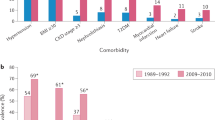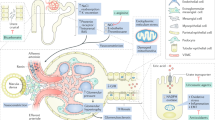Abstract
Many studies have demonstrated that hyperuricemia is associated with hypertension (HTN) development, but few studies have explored whether urate-lowering therapy (ULT), which reverses hyperuricemia, decreases the risk of incident HTN. In this retrospective cohort study, we compared the risk of incident HTN of gout patients between those undergoing and not undergoing ULT. Risks of new-onset diabetes mellitus (DM) and chronic kidney disease (CKD) were also examined. In total, 2712 gout patients from 2000 to 2012 were enrolled. Overall incidence rates of HTN, DM, and CKD were compared between 1356 patients undergoing ULT recipients and 1356 matched control patients. After adjustment for sex, age, area, comorbidities, and drugs used, the incidence rates of HTN were 4.8 and 3.0 per 100 person years for non-ULT and ULT patients, respectively. ULT patients had a lower adjusted hazard ratio (aHR) of HTN (aHR: 0.64, 95% confidence interval [CI]: 0.54–0.75, p < 0.001) than non-ULT patients. The lower risk of incident HTN after xanthine oxidase inhibitors exhibited a significant dose–response trend. ULT patients also had a lower risk of DM (aHR: 0.55, 95% CI: 0.43–0.70) than non-ULT patients. ULT patients exhibited no significant difference in CKD development (aHR: 1.04, 95% CI: 0.85–1.27) as compared with non-ULT patients. The present study revealed that ULT was associated with lower risks of incident HTN and DM, and the protective effect of xanthine oxidase inhibitors seemed to have a dose–response relationship.
This is a preview of subscription content, access via your institution
Access options
Subscribe to this journal
Receive 12 digital issues and online access to articles
$119.00 per year
only $9.92 per issue
Buy this article
- Purchase on Springer Link
- Instant access to full article PDF
Prices may be subject to local taxes which are calculated during checkout


Similar content being viewed by others
References
Cannon PJ, Stason WB, Demartini FE, Sommers SC, Laragh JH. Hyperuricemia in primary and renal hypertension. N Engl J Med. 1966;275:457–64.
Grayson PC, Kim SY, LaValley M, Choi HK. Hyperuricemia and incident hypertension: a systematic review and meta-analysis. Arthritis Care Res. 2011;63:102–10.
Wang J, Qin T, Chen J, Li Y, Wang L, Huang H, et al. Hyperuricemia and risk of incident hypertension: a systematic review and meta-analysis of observational studies. PLOS ONE. 2014;9:e114259.
Yu KH, Chen DY, Chen JH, Chen SY, Chen SM, Cheng TT, et al. Management of gout and hyperuricemia: multidisciplinary consensus in Taiwan. Int J Rheum Dis. 2018;21:772–87.
Sattui SE, Gaffo AL. Treatment of hyperuricemia in gout: current therapeutic options, latest developments and clinical implications. Ther Adv Musculoskelet Dis. 2016;8:145–59.
Mazzali M, Kanellis J, Han L, Feng L, Xia YY, Chen Q, et al. Hyperuricemia induces a primary renal arteriolopathy in rats by a blood pressure-independent mechanism. Am J Physiol Ren Physiol. 2002;282:F991–F997.
Mazzali M, Hughes J, Kim JG, Jefferson JA, Kang DH, Gordon KL, et al. Elevated uric acid increases blood pressure in the rat by a novel crystal-independent mechanism. Hypertension. 2001;38:1101–6.
Feig DI, Soletsky B, Johnson RJ. Effect of allopurinol on blood pressure of adolescents with newly diagnosed essential hypertension: a randomized trial. JAMA. 2008;300:924–32.
Soletsky B, Feig DI. Uric acid reduction rectifies prehypertension in obese adolescents. Hypertension. 2012;60:1148–56.
Cheng TM. Taiwan’s new national health insurance program: genesis and experience so far. Health Aff. 2003;22:61–76.
D’Agostino RB Jr. Propensity score methods for bias reduction in the comparison of a treatment to a non-randomized control group. Stat Med. 1998;17:2265–81.
Kahn HA, Medalie JH, Neufeld HN, Riss E, Goldbourt U. The incidence of hypertension and associated factors: the Israel ischemic heart disease study. Am Heart J. 1972;84:171–82.
Fang J, Alderman MH. Serum uric acid and cardiovascular mortality. the NHANES I epidemiologic follow-up study, 1971–92. JAMA. 2000;283:2404–10.
Feig DI, Kang DH, Johnson RJ. Uric acid and cardiovascular risk. N Engl J Med. 2008;359:1811–21.
Feig DI, John RJ. Hyperuricemia in childhood primary hypertension. Hypertension. 2003;42:247–52.
Alper AB Jr, Chen W, Yau L, Srinivasan SR, Berenson GS, Hamm LL. Childhood uric acid predicts adult blood pressure: the Bogalusa heart study. Hypertension. 2005;45:34–38.
Hunt SC, Stephenson SH, Hopkins PN, Williams RR. Predictors of an increased risk of future hypertension in Utah: a screening analysis. Hypertension. 1991;17:969–76.
Agarwal V, Hans N, Messerli FH. Effect of allopurinol on blood pressure: a systematic review and meta-analysis. J Clin Hypertens. 2013;15:435–42.
Hill AB. The environment and disease: association or causation? Proc R Soc Med. 1965;58:295–300.
Krishnan E, Pandya BJ, Chung L, Hariri A, Dabbous O. Hyperuricemia in young adults and risk of insulin resistance, prediabetes, and diabetes: a 15-year follow-up study. Am J Epidemiol. 2012;176:108–16.
Dehghan A, van Hoek M, Sijbrands EJ, Hofman A, Witteman JC. High serum uric acid as a novel risk factor for type 2 diabetes. Diabetes Care. 2008;31:361–2.
Takir M, Kostek O, Ozkok A, Elcioglu OC, Bakan A, Erek A, et al. Lowering uric acid with allopurinol improves insulin resistance and systemic inflammation in asymptomatic hyperuricemia. J Investig Med. 2015;63:924–9.
Niu SW, Chang KT, Ta A, Chang YH, Kuo IC, Hung CC, et al. Decreased incidence of diabetes in patients with gout using benzbromarone. Rheumatology. 2018;57:1574–82.
Chang HW, Lin YW, Lin MH, Lan YC, Wang RY. Associations between urate-lowering therapy and the risk of type 2 diabetes mellitus. PLOS ONE. 2019;14:e0210085.
Nakagawa T, Kang DH, Feig D, Sanchez-Lozada LG, Srinivas TR, Sautin Y, et al. Unearthing uric acid: an ancient factor with recently found significance in renal and cardiovascular disease. Kidney Int. 2006;69:1722–5.
Bellomo G, Venanzi S, Verdura C, Saronio P, Esposito A, Timio M. Association of uric acid with change in kidney function in healthy normotensive individuals. Am J Kidney Dis. 2010;56:264–72.
Sonoda H, Takase H, Dohi Y, Kimura G. Uric acid levels predict future development of chronic kidney disease. Am J Nephrol. 2011;33:352–7.
Kanbay M, Ozkara A, Selcoki Y, Isik B, Turgut F, Bavbek N, et al. Effect of treatment of hyperuricemia with allopurinol on blood pressure, creatinine clearance, and proteinuria in patients with normal renal functions. Int Urol Nephrol. 2007;39:1227–33.
Pisano A, Cernaro V, Gembillo G, D’Arrigo G, Buemi M, Bolignano D. Xanthine oxidase inhibitors for improving renal function in chronic kidney disease patients: an updated systematic review and meta-analysis. Int J Mol Sci. 2017;18:E2283.
Acknowledgements
This paper was edited by Wallace Academic Editing.
Funding
This study is supported in part by the Taiwan Ministry of Health and Welfare Clinical Trial Center (MOHW108-TDU-B-212-133004); China Medical University Hospital; Academia Sinica Stroke Biosignature Project (BM10701010021); Taiwan Ministry of Science and Technology Clinical Trial Consortium for Stroke (MOST 107-2321-B-039 -004-); Tseng-Lien Lin Foundation, Taichung, Taiwan; and Katsuzo and Kiyo Aoshima Memorial Funds, Japan.
Author information
Authors and Affiliations
Contributions
KHL, FSY, CCY and CMH participated in the study design. JCCW and HLL participated in the study coordination and data collection. HLL, KHL, and CCH participated in the data analysis. All authors contributed to the interpretation of results as well as to the discussion. KHL, FSY, and CCY all participated in paper writing.
Corresponding authors
Ethics declarations
Conflict of interest
The authors declare that they have no conflict of interest.
Additional information
Publisher’s note Springer Nature remains neutral with regard to jurisdictional claims in published maps and institutional affiliations.
Rights and permissions
About this article
Cite this article
Lin, KH., Yen, FS., Li, HL. et al. Urate-lowering therapy exerts protective effects against hypertension development in patients with gout. J Hum Hypertens 35, 351–359 (2021). https://doi.org/10.1038/s41371-020-0342-4
Received:
Revised:
Accepted:
Published:
Issue Date:
DOI: https://doi.org/10.1038/s41371-020-0342-4



